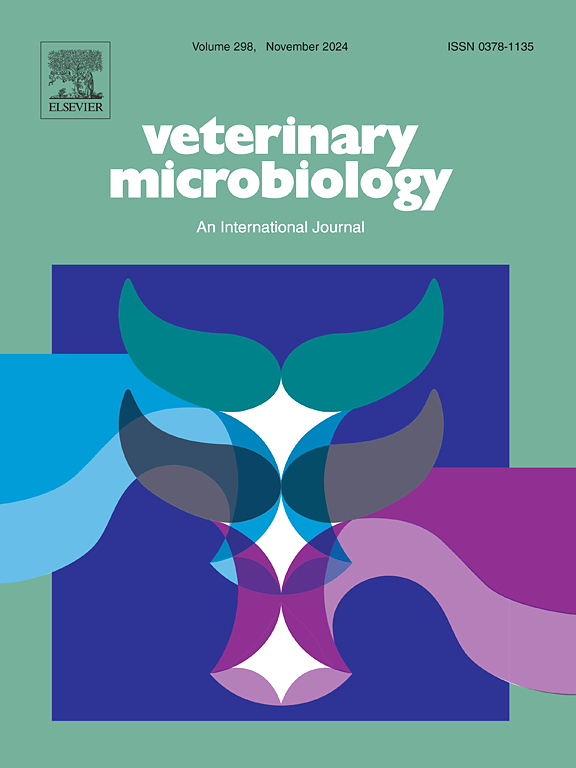猪嵌合PCV Cap蛋白重组伪狂犬病毒的免疫学特性
IF 2.4
2区 农林科学
Q3 MICROBIOLOGY
引用次数: 0
摘要
猪圆环病毒2型(PCV2)是引起猪圆环病毒相关疾病(PCVAD)的主要病原体之一。我们最近报道了PCV2包膜包埋的重组PRV (PRV-Cap)在小鼠中的免疫原性。本研究进一步评价了PRV-Cap病毒对猪的免疫保护作用。接种疫苗后,PRV- cap刺激仔猪产生抗PRV和PCV2的中和抗体,同时保护仔猪免受致命PRV、毒力PCV2b和PCV2d的攻击。外周血单个核细胞分析显示,PRV-Cap病毒可有效诱导CD4和CD8 T细胞的增殖和活化,以及T滤泡辅助细胞的增加,但γδ T和B细胞没有显着差异。与DMEM对照仔猪相比,扩增的CD4和CD8 T细胞表现出效应记忆T细胞表型,体外刺激导致PRV和pcv2特异性IFN-γ和TNF-α分泌,在免疫后21天达到峰值。综上所述,PRV- cap病毒通过同时诱导PRV和PCV2特异性体液免疫和细胞免疫,有效地预防仔猪PRV、PCV2b和PCV2d的侵袭,表明PRV- cap病毒是一种有希望和安全的PRV和PCV2联合免疫候选疫苗。本文章由计算机程序翻译,如有差异,请以英文原文为准。
Immunological characteristics of the recombinant pseudorabies virus with chimeric PCV Cap protein in pigs
Porcine circovirus type 2 (PCV2) is one of the main pathogens causing porcine circovirus-associated diseases (PCVAD). We recently reported the immunogenicity of the recombinant PRV with an envelope-embedded Cap protein of PCV2 (PRV-Cap) in mice. Here, we further evaluated the immunoprotective efficacy of PRV-Cap virus in pigs. Following vaccination, the PRV-Cap stimulated the production of neutralizing antibodies against PRV and PCV2, along with protected piglets from the challenge of the lethal PRV, the virulent PCV2b and PCV2d. Peripheral blood mononuclear cells analysis revealed that PRV-Cap virus effectively induced proliferation and activation of CD4 and CD8 T cells, as well as an increase in T follicular helper cells, although γδ T and B cells did not show significant differences. Compared to DMEM control piglets, the expanded CD4 and CD8 T cells exhibited an effector memory T cell phenotype, and in vitro stimulation led to PRV- and PCV2-specific IFN-γ and TNF-α secretion, peaking at 21 days post-immunization. In summary, PRV-Cap virus effectively prevents PRV, PCV2b and PCV2d challenges in piglets by simultaneously inducing both PRV- and PCV2-specific humoral and cellular immunity, indicating that PRV-Cap virus is a promising and safe candidate vaccine for combined PRV and PCV2 immunization.
求助全文
通过发布文献求助,成功后即可免费获取论文全文。
去求助
来源期刊

Veterinary microbiology
农林科学-兽医学
CiteScore
5.90
自引率
6.10%
发文量
221
审稿时长
52 days
期刊介绍:
Veterinary Microbiology is concerned with microbial (bacterial, fungal, viral) diseases of domesticated vertebrate animals (livestock, companion animals, fur-bearing animals, game, poultry, fish) that supply food, other useful products or companionship. In addition, Microbial diseases of wild animals living in captivity, or as members of the feral fauna will also be considered if the infections are of interest because of their interrelation with humans (zoonoses) and/or domestic animals. Studies of antimicrobial resistance are also included, provided that the results represent a substantial advance in knowledge. Authors are strongly encouraged to read - prior to submission - the Editorials (''Scope or cope'' and ''Scope or cope II'') published previously in the journal. The Editors reserve the right to suggest submission to another journal for those papers which they feel would be more appropriate for consideration by that journal.
Original research papers of high quality and novelty on aspects of control, host response, molecular biology, pathogenesis, prevention, and treatment of microbial diseases of animals are published. Papers dealing primarily with immunology, epidemiology, molecular biology and antiviral or microbial agents will only be considered if they demonstrate a clear impact on a disease. Papers focusing solely on diagnostic techniques (such as another PCR protocol or ELISA) will not be published - focus should be on a microorganism and not on a particular technique. Papers only reporting microbial sequences, transcriptomics data, or proteomics data will not be considered unless the results represent a substantial advance in knowledge.
Drug trial papers will be considered if they have general application or significance. Papers on the identification of microorganisms will also be considered, but detailed taxonomic studies do not fall within the scope of the journal. Case reports will not be published, unless they have general application or contain novel aspects. Papers of geographically limited interest, which repeat what had been established elsewhere will not be considered. The readership of the journal is global.
 求助内容:
求助内容: 应助结果提醒方式:
应助结果提醒方式:


